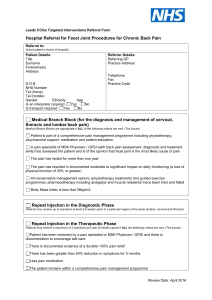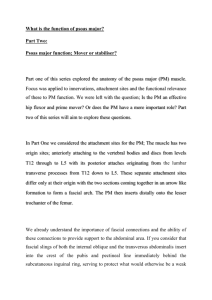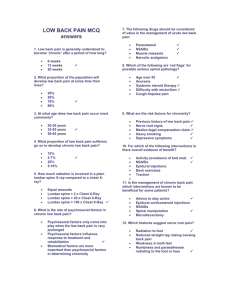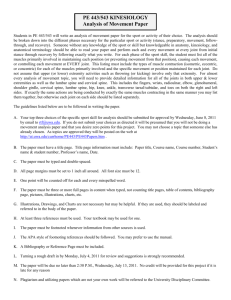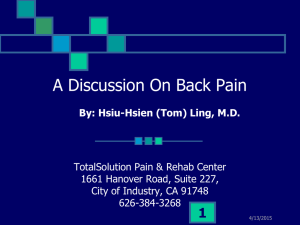Back In Motion
advertisement
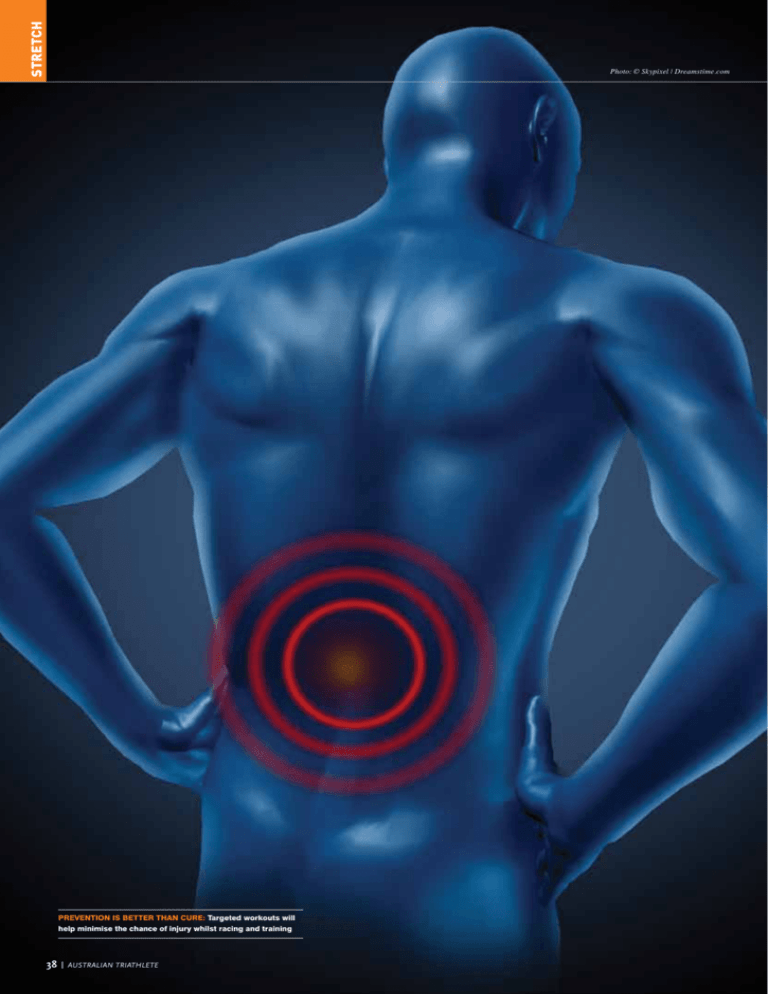
STRETCH Photo: © Skypixel | Dreamstime.com PREVENTION IS BETTER THAN CURE: Targeted workouts will help minimise the chance of injury whilst racing and training 38 | Australian Triathlete Stretch Performance Enhancement Specialist Kristian Manietta continues his series on exercises that will keep you strong, healthy, mobile and performing at your best. In this issue, he looks at how to avoid back pain. back in motion t e x t b y K r i s t i a n M a n i e t t a | p h o t o g r a p h y b y c h a r l o t t e p a u l a n d d r e a ms t i me . c o m M y last two articles looked at better ways to warm up using soft tissue techniques, movement preparation and mobility drills to get you on your way to a more efficient range of movement, better tissue health and, of course, better performance. In this issue I want to discuss caring for your back. Many athletes and non-athletes suffer from back pain that can be easily remedied without intensive therapy or drugs, it just takes some work on your part. This is true for most of the population, however there are always people who fall outside of the ‘norm’. I recommend seeing your allied health practitioner first to see if you have any contra-indications to any of these exercises shown. Typically, even though back injuries may seem to just ‘pop’ up, most of the time they are in fact a gross overuse injury. We have all heard an athlete say, “I’ve been doing this for years, I’ve never had an issue so I don’t know what happened”. You have constantly reinforced a crappy posture or pattern of movement and at some point your body is going to tap out due to muscular imbalance, stiffness or instability. It’s the proverbial straw that broke the camel’s back. Before we get into any how-to rectify exercises, we need to take a step back and have a look at some of the common causes for back pain. Most of the pain we hear athletes complain about is in the lower back. Unfortunately most of the ‘care’ advised is poorly thought out. Our first instinct is often to focus on the site of the pain instead of the underlying problem, and these are usually different places. Massaging your spinal erectors may feel good but it’s not going to get rid of the pain. Many of the causes are connected. To resolve the problem, your health practitioner will need to examine all the factors working against you and address all of them. We must wage a war on many fronts if our goal is long-term health and better performance. The following is not an exhaustive list of causes, but these are some of the common problems I see in triathletes: • • • • • • • • • • • • Bad posture and alignment Quadriceps dysfunction Hip/ankle stiffness and/or immobility Psoas dysfunction Anterior pelvic tilt Weak gluteals Excessive lordosis (curve in lumbar spine) Thoracic spine stiffness and immobility Core instability Lack of extension Instability of the lumbar spine Excessive range of motion (ROM) at lumbar spine Your main goal should be improving your posture and pelvic alignment. This will keep you healthy and doing what you love to do. It’s not very sexy I know, but it will increase your athletic performance, and avoiding debilitating lower back pain (LBP) is worth it. How your pelvis is seated will affect the rest of your body. Triathletes often suffer from lordosis and anterior pelvic tilt. Not only does this cause pain in Typically, even though back injuries may seem to just ‘pop’ up, most of the time they are in fact a gross overuse injury. — Kristian Manietta the lower back, but it affects your glute involvement and thus your overall performance. Optimal pelvic alignment means better posture, optimal muscle recruitment, better performance, better health and fewer injuries. There are numerous postural issues to be addressed for this condition: 1. 2. 3. 4. 5. Short, stiff erectors Lengthened and weak abdominals (rectus abdominus and external obliques) Short hip flexors Lengthened, inhibited, and weak gluteals Hamstrings/ITBs that are lengthened past their functional capacity How did all this happen? We can’t look at just the last domino that fell or even the ones before that. We need to go all the way back to that first domino that fell. Commonly in early stages we are asymptomatic, meaning we don’t feel any pain but if we actually looked deeper most of us would be a structural mess. One of the most commonly overlooked contributors to biomechanical issues, pelvic alignment and lower back pain is ankle mobility. Loss of ankle mobility, particularly dorsiflexion (toe-to-shin) ROM comes about from bad footwear such as running shoes with chunky heels, or wearing high heels daily, as well as how we sit (tucking feet underneath the chair with heels raised off the ground). When you shift the weight forward onto your toes, your lumbar erectors work overtime to counteract the position. Shifting the weight forward also increases pronation and over pronation causes increased recruitment of anti-pronators especially, the external hip rotators. Over time these muscles can become chronically bound up inhibiting ROM due to soft tissue restrictions. The weight leads to our quads pulling our hips down and our spinal erectors pulling up, creating the anterior pelvic tilt. When this happens we see all types of challenges. Our gluteals and our Australian Triathlete | 39 Stretch SHELC (Strengthening) Side Bridge (Strengthening / Stabilisation) Psoas Stretch (Lengthening) Psoas Release (Soft Tissue Release) core strength: Kristian demonstrates exercises that will help strengthen your back, improve your posture and eliminate issues that may arise from training abdominals are both weak and our hamstrings and ITBs are in a constant state of stretch. Furthermore our psoas, a muscle that connects in the groin all the way up to T-12 in the middle of the back becomes, overworked increasing the anterior tilt and compressing the lower back. These conditions make LBP a real possibility, along with ankle and hip mobility restriction, pulled hamstrings and Iliotibial Band Syndrome (ITB). Studies have also shown that hip rotation deficits are highly correlated to lower back pain. So how do we fix it? Back pain needs a multi-faceted approach and it’s worth saying that every training session, mobilisation, soft tissue technique, exercise or stretch included in your training mix should have a specific goal. There has to be a reason! BACK CARE MADE SIMPLE Work diligently on your posture. We need to reinforce good alignment throughout the day. While seated, legs should be at 90/90/90, meaning 90 degrees at the ankle, 90 degrees at the knee and 90 degrees at the hip. Sit up tall, with shoulders down and back (think pinching shoulder blades together). The exercises shown here will help this along, and time spent standing or kneeling at your desk each day will also help get your hips into extension and lengthen the short/ stiff muscles. Do self-myofascial work on the main contributors to lower back pain. We need to do lots of tissue quality work and this is achieved by using the GRID foam roller or our TPPT tools. The focus here is the quadriceps, the Go to: www.trispecific.com/aust-triathlete-back-care to view more images and videos outlining these exercises in full 40 | Australian Triathlete psoas, TFL/ITB*, calves, glutes, adductors, spinal erectors, thoracic spine and peroneals. Work hip mobility to get rid of excessively stiff hips. We can do this with mobility exercises in our daily warm ups or with specific sessions as shown here which include some static stretching. We need more hip motion and less lumbar motion. Work on thoracic spine stiffness and regain mobility. My last two articles in this series included drills for this. Tissue quality here is incredibly important so we use two approaches. Firstly, a diffuse approach with the foam roller, followed by a more focused approach using the TP Massage Balls in the TP2-Ball sock. Work on developing a stable lumbar spine via core stability work. We want our hips to move and our lumbar spine to be stable. People who suffer from lower back pain will find their hips are locked and they move from their lumbar spine creating ‘hip extension’ via excessive lumbar extension. We need to weld that spine to the pelvis and this is best done with exercises that stabilise the core. Then we learn to move from that stable platform. What we want to develop here is not so much core strength but endurance around the core and lumbar spine. EXAMPLE WORK OUT Soft Tissue Work Use GRID foam roller or TPPT (Trigger Point Performance Therapy) Tools - Calves - Quads, especifically rectus femoris - TFL/ITB* - Glutes - Adductors - Peroneals - Psoas - Spinal erectors Note: I’m not a big fan of hammering the ITB with a roller. I believe it just irritates it more. Some soft tissue release over the area is OK, but you definitely get a better result when you hit rectus femoris (the middle) and rectus lateralis (just to the lateral side). • • • • • • Static Stretch / Activation 1 A) Psoas or Rectus Femoris stretch, paired with 1 B) Glute Bridge 2 x sets, holding for 2 seconds 2 A) Gluteal Stretch – 2 sets, holding for 20 seconds 2 B) Side-Lying Clam – 2 sets of 10 repetitions Mobility Training Perform five repetitions each side for each exercise Easy Cat Camels / Bird Dog / Fire Hydrants Medium Mountain Climbers (to outside hands) / Single Leg Supine Bridge / Side-to-side leg swings Advanced Warrior Lunge with Twist / Pull Back Butt Kicks / Crossover Overhead Reverse Lunge Strengthening Since having anterior tilt means we are very quad dominant on the front and erector spine dominant on the back, we need to strengthen the opposing sides. For quadriceps this requires hitting the posterior chain and for erectors we need to work the front in rectus abdominus and rectus obliques. Rectus Abdominus/Obliques - Prone Brace Sequence - Side Bridge/Side Bridge with Wall Slide Glutes/Hamstrings - SHELC - Single Leg RDL Further to this, time needs to be spent on lengthening strategies outside of workouts. These can be done at home in front of the TV: • • • Increased tissue quality work with focus on hip flexors Static stretches or extra mobility work for hip flexors, quadriceps Continual reinforcement of good alignment There are a lot of pieces to the lower back pain puzzle. I’m all for enlisting the help of physical therapists but unfortunately we can’t see them every day, so at some stage you need to take your therapy into your own hands. It’s going to take dedication, as well as an understanding of the process, but the pay off for avoiding potentially debilitating lower back and hip pain is worth it, not to mention the long term benefits for health and increased performance. Australian Triathlete | 41




